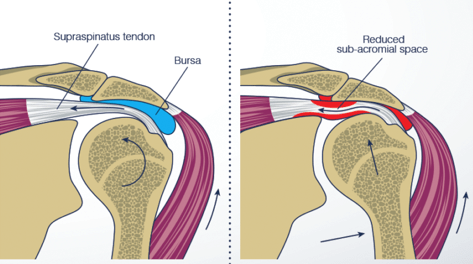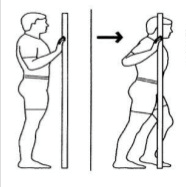Most people experience shoulder pain at some time in their lives. You can help your sore shoulder or hopefully avoid this condition altogether by improving your posture.
Shoulder impingement is a common form of shoulder pain in which structures in your shoulder joint get squeezed and possibly injured over time. There is a rotator cuff tendon and a bursa in the narrow space at the top of your shoulder called the subacromial space. This space gets reduced if you have poor posture, a rounded upper back, or forward shoulders. When you go to reach with your arm, those structures get impinged and you feel pain.

Good posture is key to improving this condition.
If your rotator cuff muscles are working properly and you maintain this narrow subacromial space with proper posture, your shoulder function should be relatively pain-free.
Here are a few exercises and pointers to help with your posture:
1- This first exercise is key! Stand tall by elongating your spine. Don’t try to squeeze shoulder blades or pull shoulders back. Instead pretend you are growing tall, or getting your height measured and you are trying to be as tall as you were in your 20’s. Your shoulders should mostly fall into the place they should be. Do this as an exercise and also be mindful of standing tall when you go to reach with your arm
2- Doorway stretch- helps to lengthen those tight chest muscles that like to pull shoulders forward. Put both hands on the door frame and gently lean forward. Make sure you are not letting your head go forward because poor head and neck position can be responsible for other problems including more shoulder pain. Hold this position for 20-30 seconds.

3- Stand tall with your heels, back shoulders and head against a wall. Step away from the wall and try to maintain this erect posture. Repeat several times. Your standing posture should be about 90% of this position.
Posture is one component for treating shoulder pain, but it is a big one. There are a multitude of shoulder exercises for shoulder impingement and which ones to use often depend on your particular situation and anatomy. You may want to see a physical therapist if you need more help. Having the proper shoulder position is the first step in recovery or prevention of shoulder pain.
